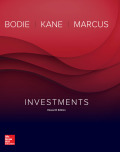
a
Adequate information:
Expected rate of
Standard deviation of the risky asset=28%
T-bill rate is 8%
Client wants to invest in your portfolio in the proportion Y
Overall portfolio’s expected rate of return =16%
To compute: The proportion of Y
Introduction:
Portfolio proportion: The calculation of portfolio proportion is simple. We have to divide each item of the stock position’s cash value by the complete or total portfolio value. This value is to be multiplied with 100 to get the value in percentages. This calculation is done to measure the dependence of the portfolio performance on each individual available stock.
b
Adequate information:
Expected
Standard deviation of the risky asset=28%
T-bill rate is 8%
Client decides to invest in your portfolio in the proportion Y
Overall portfolio’s expected rate of return =16%
To compute: TheClient’s investment proportion in available three stocks and T-bill fund.
Introduction:
Portfolio proportion: The calculation of portfolio proportion is simple. We have to divide each item of the stock position’s cash value by the complete or total portfolio value. This value is to be multiplied with 100 to get the value in percentages. This calculation is done to measure the dependence of the portfolio performance on each individual available stock.
c
Adequate information:
Expected rate of return of risky asset =18%
Standard deviation of the risky asset=28%
T-bill rate is 8%
Client decides to invest in your portfolio in the proportion Y
Overall portfolio’s expected rate of return =16%
To compute: The standard deviation of the rate of return of client’s portfolio
Introduction:
Portfolio proportion: The calculation of portfolio proportion is simple. We have to divide each item of the stock position’s cash value by the complete or total portfolio value. This value is to be multiplied with 100 to get the value in percentages. This calculation is done to measure the dependence of the portfolio performance on each individual available stock.
Want to see the full answer?
Check out a sample textbook solution
Chapter 6 Solutions
EBK INVESTMENTS
- An analyst has modeled the stock of a company using the Fama-French three-factor model. The market return is 10%, the return on the SMB portfolio (rSMB) is 3.2%, and the return on the HML portfolio (rHML) is 4.8%. If ai = 0, bi = 1.2, ci = 20.4, and di = 1.3, what is the stock’s predicted return?arrow_forwardAPT An analyst has modeled the stock of Crisp Trucking using a two-factor APT model. The risk-free rate is 6%, the expected return on the first factor (r1) is 12%, and the expected return on the second factor (r2) is 8%. If bi1 = 0.7 and bi2 = 0.9, what is Crisp’s required return?arrow_forwardYour client is shocked at how much risk Blandy stock has and would like to reduce the level of risk. You suggest that the client sell 25% of the Blandy stock and create a portfolio with 75% Blandy stock and 25% in the high-risk Gourmange stock. How do you suppose the client will react to replacing some of the Blandy stock with high-risk stock? Show the client what the proposed portfolio return would have been in each year of the sample. Then calculate the average return and standard deviation using the portfolios annual returns. How does the risk of this two-stock portfolio compare with the risk of the individual stocks if they were held in isolation?arrow_forward
- You manage a risky portfolio with expected rate of return of 18% and standard deviation of 28%. The T-bill rate is 8%. a. Your client chooses to invest 70% of a portfolio in your fund and 30% in a T-bill money market fund. What is the expected value and standard deviation of the rate of return on his portfolio? b. What is the reward-to-volatility ratio (S) of your risky portfolio? Your client’s? c. Draw the CAL of your portfolio on an expected return–standard deviation diagram. What is the slope of the CAL? Show the position of your client on your fund’s CAL. d. Suppose that your client decides to invest in your portfolio a proportion y of the total investment budget so that the overall portfolio will have an expected rate of return of 16%. What is the proportion y? What is the standard deviation of the rate of return on your client’s portfolio? e. Suppose that your client prefers to invest in your fund a proportion y that maximizes the expected return on the complete portfolio subject…arrow_forwardAssume that you manage a risky portfolio with an expected rate of return of 15% and a standard deviation of 40%. The T-bill rate is 5% A client prefers to invest in your portfolio a proportion (y) that maximizes the expected return on the overall portfolio subject to the constraint that the overall portfolio's standard deviation will not exceed 30%. What is the investment proportion, y? What is the expected rate of return on the overall portfolioarrow_forward
 EBK CONTEMPORARY FINANCIAL MANAGEMENTFinanceISBN:9781337514835Author:MOYERPublisher:CENGAGE LEARNING - CONSIGNMENT
EBK CONTEMPORARY FINANCIAL MANAGEMENTFinanceISBN:9781337514835Author:MOYERPublisher:CENGAGE LEARNING - CONSIGNMENT
 Intermediate Financial Management (MindTap Course...FinanceISBN:9781337395083Author:Eugene F. Brigham, Phillip R. DavesPublisher:Cengage Learning
Intermediate Financial Management (MindTap Course...FinanceISBN:9781337395083Author:Eugene F. Brigham, Phillip R. DavesPublisher:Cengage Learning




